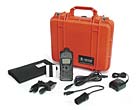
What a difference a year makes to some wallets.
The nation’s top corporate chief security officers (CSO), those executives in charge of security for global companies in the U.S., are paid, on average, more than $293,000 annually in total cash compensation (base salary and bonus paid), according to a compensation survey by compensation consulting and research firm, Foushée Group of Ft. Meyers.
“The fifth annual survey indicates the continued recognition and importance of the security groups within the organization and their contribution to the overall profitability of their companies. Chief Security Officers not only have to plan for international and domestic threats, but are increasingly involved with the security requirements for information systems and planning for potential public health pandemics, which could significantly impact a company’s ability to operate,” researcher Stephen Walker told The Zalud Report.

Satellite phones in grab and go mode aim at anywhere communications.
11 percent solution
“When comparing 2005 to the 2006 compensation data for chief security officers, there is an 11 percent increase in total cash compensation for the top job, significantly higher than the national norm,” Walker said. Based on earlier surveys by the Foushée Group, CSO salary cash compensation since the 9/11/01 terrorist attacks has increased 44.7 percent, significantly more than the national average.Foushée Group conducted the survey in cooperation with the International Security Management Association. ISMA members include representatives from more than half of the Fortune 100 and a quarter of the Global 200, spanning five continents and every industry. Inquiries to purchase the 2006 Security and Compliance Compensation Report or participate in the 2007 survey:www.fousheesurvey.comor (239) 282-1929.
Of course, and beyond overhead, technology budgets for CSOs also are rising to meet new-age threats from international terrorism, disasters and health pandemics.
As Security Magazine Publisher Mark McCourt writes in this issue, better communication is a hot button. There’s also a growing need for equipment to handle evacuations, no matter the cause.

Evac-Pack works In wired “smart buildings,” instrumented with an 802.11 network layer, to “push” a map of each floor into the wearer’s eyepiece, with blue dots indicating occupied rooms.
Evacuation communications
If you envy those network reporters using satellite phones but shutter at the price tag, check out Roadpost’s “Grab & Go” emergency kit which includes an Iridium satellite handset, extra batteries and a solar charger bundled in a rugged, waterproof and shockproof carrying case. The approach means that security executives can easily access portable satellite services with little disruption to business operations.Then there’s a wearable communication system under development which aids emergency response. Called Evac-Pack, it’s a wearable, wireless, multimodal communication system that allows first-responders and security officers in emergency evacuations to maintain constant two-way communication with an operations center. It is in development at UC Irvine’s California Institute for Telecommunications and Information Technology.
It looks like futuristic hiking gear. The GPS/Bluetooth-equipped apparatus consists of a backpack-transported computer, video camera, wearable keyboard and wireless mouse. An eyeglass-mounted visual display, and full-duplex audio microphone and earpiece allow updated real-time situation awareness. A sensor detects and communicates levels of dangerous gases present in an environment, while an avionics-designed helmet incorporates compass, accelerometer and thermometer to transmit images and data to the control center.
Evac-Pack was conceived for a National Science Foundation-funded research project called ResCUE -- Responding to Crises and Unexpected Events. Principal investigator Sharad Mehrotra, UCI professor of computer science systems, conceived the apparatus, while Chris Davison, the project’s test-bed technology manager, assembled it using off-the-shelf components.
